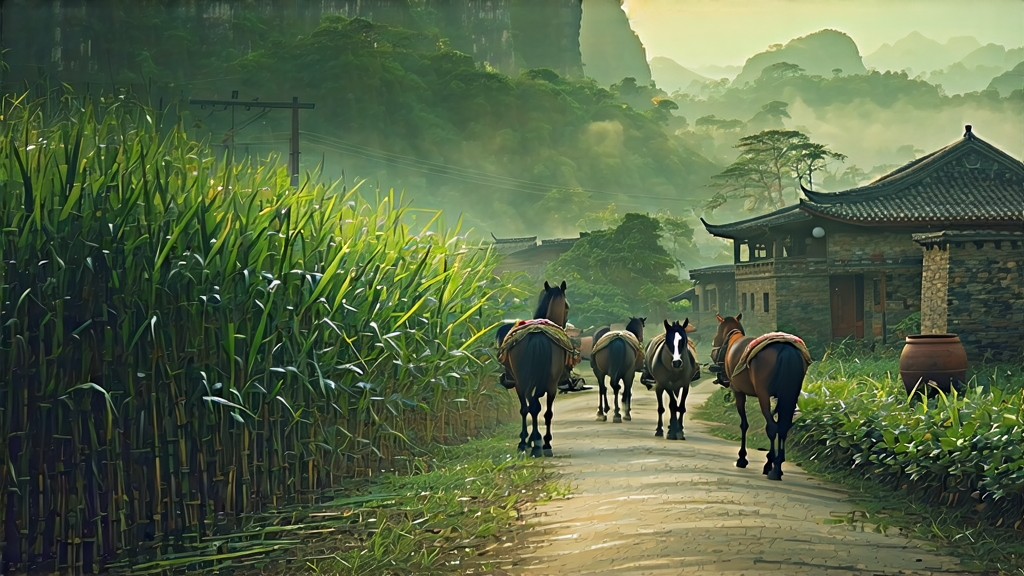
Tucked away in the humid, karst-pocked mountains of southern China’s Guangxi Zhuang Autonomous Region lies a tea that once fueled caravan mules on the ancient Tea Horse Road and still quietly ferments in dark cellars, growing smoother and sweeter with every passing season. International drinkers may nod knowingly at Pu-erh, yet its lesser-known cousin—Liu Bao—offers an even deeper dive into the alchemy of microbes, time, and terroir that defines dark tea (heicha). This article invites you to meet Liu Bao: its 1,500-year back-story, the craft that turns fresh leaf into “earthy velvet,” and the simple ritual that coaxes its camphor-sweet soul into your cup.
-
From Song Dynasty Tribute to Global Gongfu
Liu Bao’s name simply means “Six Forts,” a cluster of villages in Wuzhou prefecture where Tang-era growers first discovered that a summer downpour could accidentally “wet” their tea, darkening the leaf and softening its edge. By the Song (960-1279) the imperial court had listed Liu Bao as “gong cha” (tribute tea), and by the Qing it was compressed into 40 kg bamboo baskets, lashed to mule saddles, and traded for Tibetan warhorses—hence the Tea Horse Road. In the humid cargo holds of 19th-century clipper ships, the tea continued to ferment, arriving in Kuala Lumpur’s tin-mining kongsis with a mellow, medicinal character that endeared it to Cantonese laborers. Today the same baskets age in climate-controlled caves beneath Wuzhou, and boutique lots appear in Berlin cafés and Brooklyn teahouses, proving that great microbes travel well. -
Terroir: Where Rocks, Rivers, and Microbes Conspire
Guangxi’s subtropical heat (annual mean 21 °C) and 70–85 % relative humidity create a natural “wet piling” incubator. The Liu Bao growing band sits at 200–600 m elevation on red lateritic soil rich in iron and potassium. Indigenous large-leaf Camellia sinensis var. assamica trees—some 200 years old—sink deep taproots into limestone fissures, pulling up minerals that translate into a cooling, mentholated finish. Crucially, the local environment harbors a unique microbial consortium: Eurotium cristatum (the “golden flower” also prized in Hunan Fu brick), Aspergillus niger, and a lactic-acid bacterium christened Lactobacillus liubaoensis in 2018. These organisms colonize the leaf during piling and later bloom again inside the bamboo basket, giving Liu Bao its signature betel-nut, orchid, and camphor aromatics. -
Craft: The Eight-Step Journey from Leaf to Living Artifact
Step 1: Pluck—one bud plus the third or fourth mature leaf, May through September, when alkaloids are moderate and polyphenols are high.
Step 2: Solar Wilt—leaves are spread 3 cm thick on bamboo trays under morning sun for 30 minutes, softening cell walls without oxidizing the catechins.
Step 3: Indoor Wilt—moved to 28 °C, 75 % RH for 4–6 h; the leaf loses 60 % moisture, edges curl, and a grassy note fades.
Step 4: Kill-Green—flash-firing at 200 °C for 3 minutes deactivates PPO enzymes, locking in a dark-olive color.
Step 5: Rolling—40 minutes of light pressure ruptures 30 % of cells, enough to release sticky polysaccharides that later feed microbes.
Step 6: Sun-Drying—leaves are spread on coconut-leaf mats for a full day until moisture drops to 10 %; UV radiation sterilizes surface pathogens yet preserves endospores.
Step 7: Wet Piling—unique to dark teas. Piles 1 m high and 70 °C at the core are sprayed with mountain spring water (pH 6.2) and covered in jute sacks. Every five days the pile is turned; oxygen re-activates thermophilic fungi, while anaerobic pockets breed lactic acid. After 25–30 days the leaf turns chestnut-brown, amino acids triple, and caffeine drops